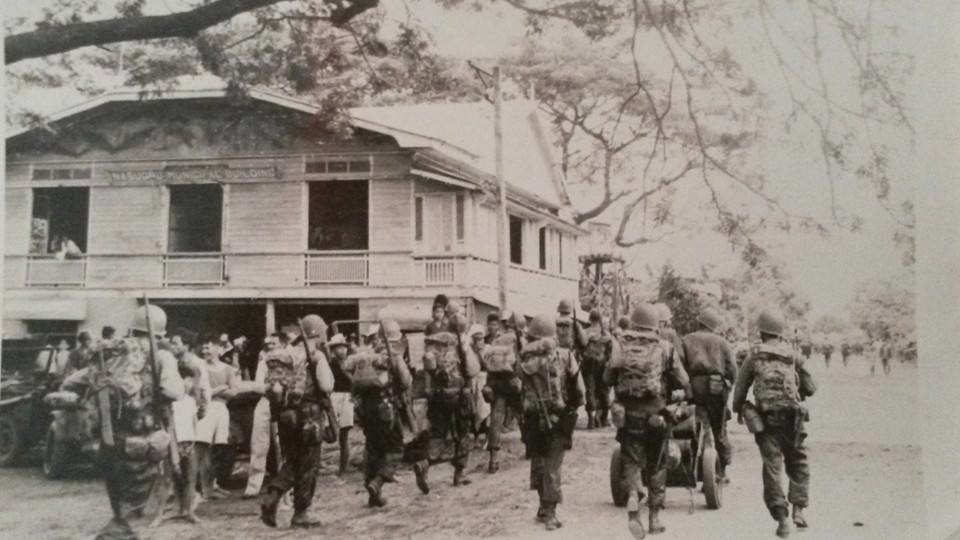Memorial Day May 30, 2016
To our Liberators, we are forever in your debt.
I aim to make the entire Philippines the biggest American Battle Monument in the world, so help me God. The history of the Philippines has been hidden from us, especially the part that the Philippines was a U.S. territory when WWII broke out and how U.S. forces defended and liberated the Philippines.
Our home town, Las Piñas was liberated on 4 Feb. 1945. We need a major re-education program so Filipinos would know how much we owe our liberators.
11th Airborne: Operation Mike 6 Part II
The 11th Airborne conducted the second part of Mike 6, again staging an amphibious landing instead of jumping. They landed some 45 miles southwest of Manila (January 31–X-ray Day). This totally surprised the Japanese who were fixed on the American drive from the north. Two regiments of the 11th Airborne Division, the 187th GIR commanded by Col. Harry B Hildebrand & 188th GIR, led by Col Robert H Soule and under Maj. Gen. Joseph M. Swing, landed unopposed. The paratroopers were able to seize a bridge near the beach before the bewildered Japanese could demolish it. This enabled the paratroopers to begin the southern drive on Manila.
The Division’s Third Regiment (511th Parachute), did jump to join the other two regiments. They were soon advancing north along a rare paved highway. Filipino civilians lined the highway cheering them on. The 11th Airborne Division was one of Lt. Gen. Robert L. Eichelberger’s Eighth Army units which had been pushing up the New Guinea coast. The Division was initially to be used to contain Japanese troops throughout southwestern Luzon. MacArthur decided to use the Division to add to the drive on Manila.
It proved to be an epic drive. The Japanese mounted a defense near Imus, only 5 miles south of Manila (February 3). An entrenched force of about 50 Japanese held a position centered on an old stone building. A bombardment by the battalion’s 75-mm. howitzers failed to dislodge them. T. Sgt. Robert C. Steel (“D” Co.) managed to get on the roof and poured in gasoline with a phosphorous grenade. The Japanese rushed out and were mowed down.
Three miles further up the road towards Manila was the Las Piñas River bridge. A Japanese detachment on the north bank of the river was ready to blow it. As a result of poor communications they were unaware of the fighting at Imus and were surprised when the Americans appeared. The paratroopers managed to secure the bridge before the Japanese demolished it. One battalion guarded the vital span while another continued the drive on Mania.
How did the paratroopers know it was safe to enter the town proper of Las Piñas? Elements of the 11th Airborne entered Las Piñas at around 4pm. Going north towards Manila, after the Las Piñas bridge is about a hundred yards of the road with salt beds on both sides.
In front of the cluster of houses a man on horseback was carrying the American flag. This was the indication that there were no more Japanese soldiers in town. The man was Florencio Aldana, the head of the local guerrillas and my mother’s cousin. He was the son of Elias Aldana a four-term mayor of Las Piñas. His cousin Bernardo Aldana was the town mayor when the Japanese attacked Pearl Harbor. (Ricardo Santos told me this story.)
The next day as the Division approached the southern outskirts of Manila, they were stopped at Parañaque River, this was part of the main Japanese defenses around Manila. A damaged bridge stopped them. And they were hit with artillery fire from Nichols Field. [U.S. Army, pp. 11-12.] One division did not have the strength to break through here. But it meant that the Japanese defenders could anticipate no support from Shimbu Group to the east. This left the Japanese in Manila completely cut off.”
On Feb. 8, 1945 T.Sgt. Robert C. Steel was killed in action in Manila.
From: Liberation of the Philippines: Luzon (1945)
http://histclo.com/essay/war/ww2/camp/pac/phil/lib-luz.html

